Estimating the Heat Flux from Pool Fire
Odhad tepelného toku z Pool Fire
M. Skřínská1*, S. Benyahia2, J. Skřínský2, V. Sluka1, M. Pražáková1, S. Malý1
1Výzkumný ústav bezpečnosti práce, Jeruzalémská 1283/9, 110 00 Praha 1 - Nové Město, skrinska@vubp-praha.cz
2Vysoká škola báňská Technická univerzita Ostrava, Výzkumné energetické centrum, 17. listopadu 15/2172 Ostrava - Poruba
Abstract
Large quantity of models for pool fire characteristics is available in the literature. In the present work, we implemented different possibilities of heat fraction calculation and we introduced the flame length in order to calculate the point source-target distance. Finally we do not consider the atmospheric stability as constant but we introduced simple mathematical correlation and compare both the model with and without this parameter. The present contribution shows that the Effects model and presented model are almost same based on the heat flux calculation results and therefore that the implementation of the Yellow book model is well done. Nevertheless, from an area of the pool of approximately 5000 m2 there are differences between both models. Those differences are evaluated about 10%. Moreover, it is interesting to evaluate the pool fire behavior according to the nature of the fuel. For the same scenario that is say for the same ambient condition and mass of fuel the variation of the heat of flux as a function to the area of the pool for benzene, gasoline and methanol were shown. The methanol burning is characterized by flame which is not enough visible. We can conclude that more the soot is present when a fuel burn more the heat of flux is affected.
Keywords: Pool Fire, Initial Fuel Area, Heat Flux
Abstrakt
V literatuře je popsán velký počet modelů výpočtu charakteristik jevu požáru kaluže. V tomto příspěvku je prezentován možný způsob výpočtu hustoty tepelného toku se zavedením veličiny délky plamene, za účelem stanovení vzdálenosti zdroj-příjemce. Atmosférická stabilita není uvažována jako konstantní hodnota, ale je matematickým vztahem definována jako fyzikální veličina závislá na parciálním tlaku nasycených par a výsledek výpočtu je proveden s a bez tohoto parametru. Výsledky ukazují, že výsledky získané použitím programu Effects a prezentovaného modelu jsou téměř shodné a tedy, že je implementace matematického modelu dle Yellowbook provedena korektně. Nicméně, od velikosti plochy přibližně 5000 m2 je patrný rozdíl mezi oběma modely. Tyto rozdíly jsou hodnoceny jako 10%. Jako zajímavé se rovněž jevilo zhodnotit požár kaluže v závislosti na druhu paliva. Toto zhodnocení bylo provedeno pro stejný scénář, jmenovitě pro standardní atmosférické podmínky a stejnou hmotnost paliva. Byla sledována hodnota hustoty tepelného toku v závislosti na velikosti plochy kaluže pro benzen, benzín a metanol. Hoření metanolu se vyznačuje tím, že plamen není dostatečně viditelný. Závěrem lze konstatovat, že množství sazí vznikající při hoření ovlivňuje hodnotu hustoty tepelného toku.
Klíčová slova: Pool Fire, Počáteční plocha kaluže, Hustota tepelného toku
1. Introduction
All process industry accidents fall under three broad categories: fire, explosion, and toxic release. Of these fires is the most common, followed by explosions and toxic releases. Among the commonly occurring fires in chemical process industry are pool fires very often phenomenon. Pool fires are frequently involved in fire accidents (Planas, 2012). From simulation point of view is pool fire complicated phenomenon and the theoretical treatment is correspondingly complex. There is a considerable literature related to pool fires (Lees, 2012; CCPS, 2000). Apart from the large number of publications on pool fire themselves; there are many relevant studies on flames such as heat radiation from flames (Skrinsky and Marek et al., 2013; Skrinsky and Sluka et al., 2013). Much of the early work has been done on relatively small diameter pool fires. Subsequent studies indicate that the effect of pool diameter is important and that it is preferable to carry out studies on large pool fires. As the diameter of pool fire increased, there is progression from a laminar to a transition and finally to a turbulent regime (Lees, 2012). The wide variations of possible aspects associated with pool fire characteristics calculations and treatments by different authors can give widely varying estimates (Lees, 2012). At the same time, experiments could be expensive and time consuming, especially at large scale conditions, at which many pool fires occur. Therefore, methods are being sought with which heat flux can be calculated in reasonable time. For risk assessment of industrial processes (Hollá, 2014) and emergency planning use (Benyahia, 2014), it is important to have a model for prediction of pool fire parameters to be able evaluate its consequences. The present contribution presents heat flux of stoichiometric benzene - air, gasoline - air and methanol - air mixtures calculated for various initial diameters.
2. Model description
Simplified modelling of pool fires covers following aspects: (1) flame geometry, (2) liquid burning rate, (3) flame characteristics, (4) heat flux radiated and (5) view factor. Review of pool fire models have been given by several authors and shows that there are three different ways of calculating the heat flux radiated from a pool fire: (1) the use of a value of the fraction of the heat radiated, (2) the use of a value for the surface emissivity and (3) the estimation from the flame properties such as flame temperature and emissivity. The presented 22 steps model has been simulated numerically within Java program language and NetBeans IDE 7.4 environment to provide the heat flux dependences. The model is adaptations of pool fire model described in (Yellow book, 1997).
In Figure 1 the following symbols are used: A0 is surface area of the pool; dh is hole diameter of the release point; ΔHc is combustion heat of the flammable material at its boiling point; ΔHv is vaporisation heat of the flammable material at its boiling point; Cp is specific heat capacity at constant pressure; Tb is the boiling point of the liquid; Ta is the atmospheric temperature; Dmax is maximum diameter of the pool fire; m´´ is mass burning rate; ρair is density of air; g is gravitational constant (9.81 m/s2); c is variable defined by Freude and Reynolds number; Fr is Freude number; τ is atmospheric transmissivity; Pw is partial vapor pressure of water in air at a relative humidity RH; x is distance from the center of the Fire Ball to the radiated object; Fv is geometrical view factor for the vertical plane of the radiated object; Fh is the geometrical view factor for the horizontal plane of the radiated object; SEPact is actual surface emissive power, which is the average radiation emittance (emissive power) of the flame surface; Fmax is maximum geometrical view factor of the radiated object; τa is the atmospheric transmissivity.
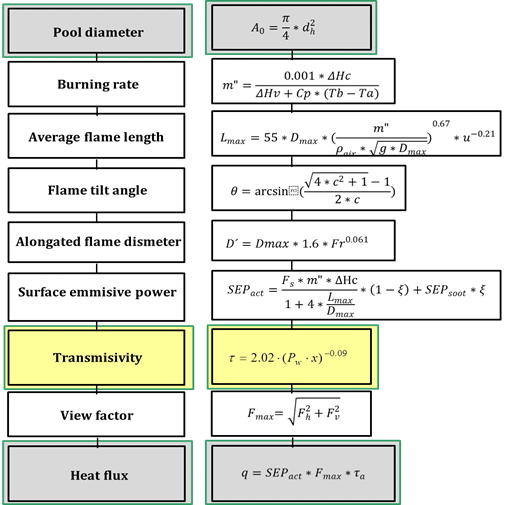
Figure 1: Scheme of the program implemented in JAVA environment
From the Figure 1 it is possible to recognize that presented model is clearly an approximation, but in view of the simplicity of the related computation it has some value in providing an order-of-magnitude estimate. As the difference with the (Yellow book, 1997) model, we simply implemented different equation for transmissivity into the program.
3. Analysis
As regards the actual configuration, the type of fuel and environment conditions had to be taking into account. Benzene was chosen in order to establish the presented model for unconfined pool fire. Thus, atmosphere, wind and tank parameters had to be described. Fuel characteristics and environment conditions used for calculation are summarized in the Table 1. The scenario chosen to test the mathematical model is an accidental release of benzene at ground level. To validate the model, it was necessary to compare it with Effects software. To ensure the compatibility of input data for comparison we selected them from (Yellow Book, 1997).
| Symbol | Name | Value | Unit |
|---|---|---|---|
| V | Volume of the tank | 196 | m3 |
| D | Diameter of the tank | 5 | m |
| At | Cross-sectional area of the tank | 19.63 | m2 |
| A | Area of the pool | 1415 | m2 |
| hi | Initial height of liquid above the release | 10 | m |
| dh | Hole diameter of the release point | 0.1 | m |
| C0 | Flow coefficient of fluids through a circular hole | 0.7 | - |
| δ | Pool thickness | 0.02 | m3 |
| ρ | Density of fuel | 882 | kg×m-3 |
| m | Mass of fuel | 24960 | kg |
| m” | Burning rate | 0.085 | kg×m-2×s-1 |
| k*β | k*β product | 2.7 | m-1 |
| ∆Hc | Heat of combustion | 4.015×107 | J×kg-1 |
| ν | Kinematic viscosity of the air | 156×10-7 | m2×s-1 |
| uw | Wind speed | 5 | m×s-1 |
| Tf | Temperature of the radiator surface of the flame | 1200 | K |
| Tair | Ambient temperature | 298 | K |
| Pair | Atmospheric pressure | 1.0133×105 | Pa |
| Pinit | Initial pressure | 105 | Pa |
| γ | Poisson constant | 1.4 | - |
| RH | Relative humidity | 0.2497 | - |
| pw0 | Saturated vapour pressure of water in air | 3170 | Pa |
| pc | Vapour pressure of carbon-dioxide | 30.3975 | Pa |
| ξ | Fraction of the surface covered by soot | 0.8 | - |
| ρair | Density of the air | 1.2243 | kg×m-3 |
| x | Distance from the centre of pool | 100 | m |
| SEPsoot | Surface Emissive Power of soot | 20 000 | J×m2×s-1 |
| Fs | Fraction of the heat radiated from the flame surface | 0.4 | - |
| g | Gravitational acceleration | 9.80665 | m×s-2 |
Table 1: Input data for calculation taken from (Yellow Book, 1997)
4. Results and discussions
Thermal radiation model have been developed. For the fuel types considered in this study, the present model predicts the parameters with the difference in Table 2 in comparison with the Effects software.
| Parameter | Effects | Presented | Difference (%) |
|---|---|---|---|
| Diameter of the pool (m) | 42.4460 | 42.4460 | 0.0000 |
| Height of the flame (m) | 47.8920 | 47.9130 | 0.0440 |
| Tilt angle (°) | 49.4710 | 49.3110 | 0.3230 |
| Atmospheric transmissivity (%) | 60.7310 | 61.0000 | 0.4430 |
| View Factor (-) | 0.1000 | 0.1001 | 0.0400 |
| Heat of flux (W/m2) | 4014.0000 | 3999.0000 | 0.3740 |
Table 2: The results of the comparison with Effects model
According to the Table 2 we can see that the model is correct. As the model is correct for benzene, we decided to compare presented model with another fuels which were gasoline and methanol. The aim was to see the variation of the heat of flux according to the area of the pool and evaluate the limit of the model. The results of the simulation are in Figure 2.
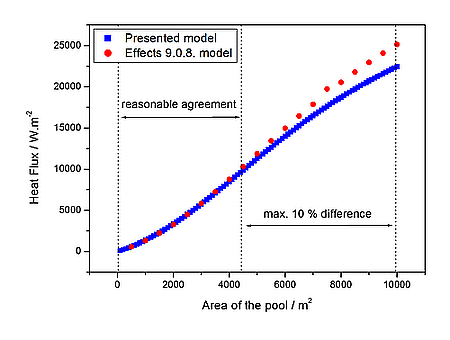
Figure 2: Heat flux as a function of area of the pool (pool diameter)
We can see that the Effects model and present model results are almost similar up to approximately 5000 m2 (corresponding diameter 80 m). Nevertheless, from an area of the pool of approximately 5000 m2 there are differences between both models. Those differences are evaluated to be about 10 %. Moreover, it is interesting to evaluate the pool fire behavior according to the nature of the fuel.
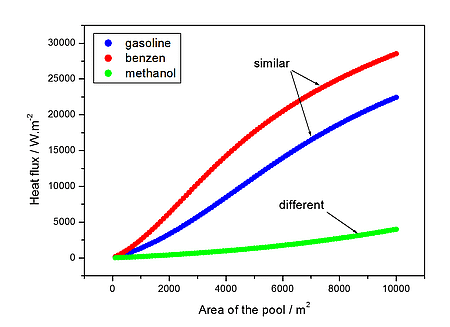
Figure 3: Heat flux according to the nature of the fuel
Figure 3 shows the variation of the heat of flux in function to the area of the pool for benzene, gasoline and methanol for the same scenario, the same initial condition and mass of fuel. The effective heat flux has the similar dependence for benzene and gasoline, but slightly different for methanol as a fuel. That could be of its chemical composition and –OH group and therefore different kind of and amount of soot formation. The average burning rate per unit area per unit time, heat of combustion, and fuel-specific properties have been tabulated for a number of different fuels and could also affected the heat flux from fuel.
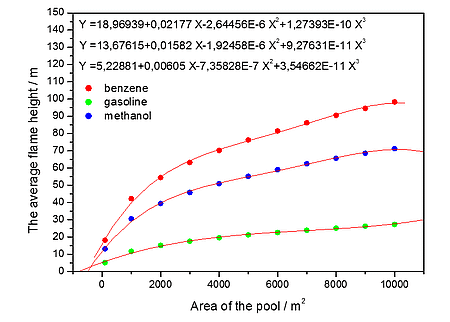
Figure 4: The average flame height as a function of pool area and the polynomial and approximation parameters developed for the benzene, gasoline and methanol
Figure 4 describes the average flame height calculations and approximations for benzene, gasoline and methanol. The polynomial approximation compares well with the experimental values determined. Data correlations by equations developed in Figure 4 are based on third-, fourth-, and fifth-order polynomial functions (the first one used as approximation). All of them were performed together with iterative Levenberg-Marquardt calculations. Even if the polynomial expression doesn´t have physical meaning it fits the experimental data within the minimal error in whole interval of pool areas. Once the regression coefficients are determined the area of the pool is the only unknown which has potential applicability for the easy assessment of fire and explosion hazards.
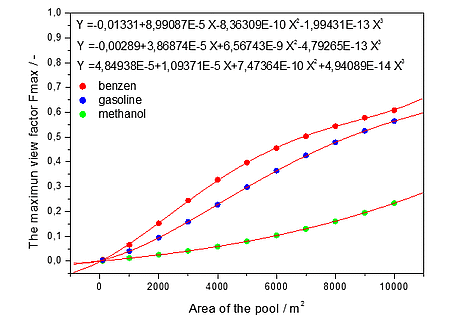
Figure 5: The maximum view factor as a function of pool area
Figure 5 shows the maximum view factor as a function of pool area. The approximation function constants for average flame height maximum view factor as a function of pool area were accurately determined for the first time, and the results of the approximation compare well with the mathematical calculations and experimental values in Figure 2. The approximations may be proposed as potentially applicable for the assessment of pool fire hazards.
5. Conclusion
A theoretical study of benzene, gasoline and methanol pool fires was conducted considering different initial fuel areas for different diameter trays from 1 m2 to 104 m2. Heat flux distributions were calculated and the results were compared with Effects software 9.0.8. The major conclusions are summarized below:
(1) The radiant heat flux model from pool fire flames has been developed. For the fuel types considered in this study (benzene, gasoline, methanol) the present model predicts the heat flux fairly well in comparison with the software Effects. However, it should be noted that both the presented and Effects models are exclusively dependent on the data used to calibrate them.
(2) For a given pool diameter higher than approximately 80 m (corresponding to pool area 5024 m2) the presented model under-predict the heat flux as shown in Figure 2. The over-prediction shown by the present model is negligible.
(3) The approximation function constants for average flame height maximum view factor as a function of pool area were accurately determined.
(4) Our future plan is to experimentally analyze estimated heat flux from studied pool fires.
Acknowledgement
J.S. is thankful to the financial support of two grants: (1) Innovation for Efficiency and Environment, reg. no. ED0036/01/01 supported by Operation Program Research and development for Innovation and financed by the Ministry of Education, Youth and Sports; (2) Innovation for Efficiency and Environment - Growth, reg. no. LO1403 supported by National Programme for Sustainability and financed by the Ministry of Education, Youth and Sports.
Literature
BENYAHIA, S. …[et al.]. Characterization of Heat Flux from Hydrocarbon Pool Fires. In Bezpečné Slovensko a Európska Únia 2014, Košice, Slovenská republika 2014. S. 25-31.
CCPS: Centre for Chemical Process Safety. Guidelines for Chemical Process Quantitative Risk Analysis. New York: The American Institute of Chemical Engineering, 2000.
HOLLÁ, K. Complex model for risk assessment of industrial processes. IDRiM Journal, 2014, no. 4, s. 93-102.
LEES, F. P. Loss Prevention in the Process Industries: Hazard Identification, Assessment, and Controls: volume 1-3. Oxford: Butterworth-Heinemann, 2012.
PLANAS-CUCHI, E.; MONTIEL, H.; CASAL, J. A survey of the origin, type and consequences of fire accidents in process plants and in the transportation of hazardous materials. Trans. IchemE, 2012, vol. 75, s. 3–8.
SKŘÍNSKÝ, Jan …[et al.]. Description of Physical-Chemical Parameters of Pool-fire. Časopis výzkumu a aplikací v profesionální bezpečnosti [online], 2013, roč. 6, č. 3-4. Dostupný z WWW: <http://www.bozpinfo.cz/josra/josra-03-04-2013/pool-fire.html>. ISSN 1803-3687.
SKŘÍNSKÝ, Jan …[et al.]. Application of emergency planning criteria for the control of major accident hazards-calculation of the consequences of fire accidents, Safety, Reliability and Risk Analysis: Beyond the Horizon - Proceedings of the European Safety and Reliability Conference, ESREL (2013) 135-142.
BOSCH, J. H. van den. Methods for the Calculation of Physical Effects: ‘Yellow Book’ CPR 14E. Hague: Committee for the Prevention of Disasters, 1997.
Vzorová citace
SKŘÍNSKÁ, M. …[et al.]. Estimating the Heat Flux from Pool Fire. Časopis výzkumu a aplikací v profesionální bezpečnosti [online], 2015, roč. 8, č. 4. Dostupný z WWW: <http://www.bozpinfo.cz/josra/josra-04-2015/heat-flux-from-pool-fire.html>. ISSN 1803-3687.
Užitečné odkazy
Provozovatel portálu
Jeruzalémská 1283/9
110 00 Praha 1


